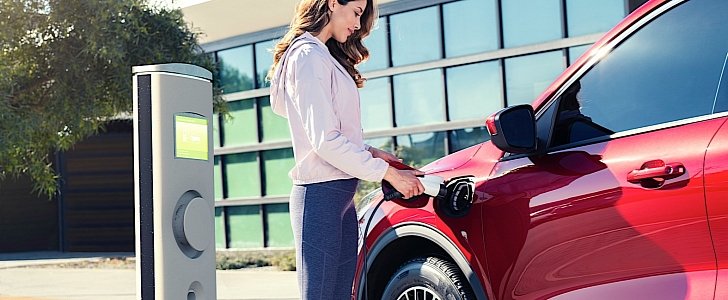The latest Ford Escape family of cars introduced by the Blue Oval is one of the most comprehensive ones to date in the carmaker’s portfolio as far as powertrains go. All types of propulsion, except for full electric, have been envisioned for the model.
The plug-in hybrid Escape, announced ever since the model was first unveiled, received its price tag in December and is now ready for the road at the hands of its customers. Ford plans to sell the model for under $35,000 (rebates included), and throws in an estimated EPA combined range of 100 MPGe.
When it first came under the spotlight, the PHEV Escape had an all electric range of 30 miles of range in electric mode (48 km), but now Ford says that range is 37 miles (60 km).
“The original Ford Escape was the world’s first hybrid SUV and the all-new Ford Escape Plug-in Hybrid represents how far we’ve come in technology and efficiency,” said in a statement Hau Thai-Tang, Ford chief product development and purchasing officer.
“The all-new Escape plug-in has more power and more passenger space than the Fusion Energi plug-in, as well as up to four times the cargo volume behind its second-row seats.”
The car is equipped with a Level 1/Level 2 AC charging port and depending on what charging solution is chosen, the time needed to get it full varies. When using a 110-volt Level 1 charger, it takes 10 to 11 hours, whereas the Level 2 charger does it in just 3.5 hours.
Aside from the plug-in hybrid, the Escape is also powered by conventional engines, depending on the trim level. The Titanium comes equipped with a 2.0-liter EcoBoost (250 horsepower and 275 lb.-ft. of torque), while the S, SE, and SEL trims pack a brand new 1.5-liter EcoBoost that develops 180 horsepower and 177 lb.-ft. of torque.
This latter engine is the first one deployed in North America by Ford that uses cylinder deactivation.
When it first came under the spotlight, the PHEV Escape had an all electric range of 30 miles of range in electric mode (48 km), but now Ford says that range is 37 miles (60 km).
“The original Ford Escape was the world’s first hybrid SUV and the all-new Ford Escape Plug-in Hybrid represents how far we’ve come in technology and efficiency,” said in a statement Hau Thai-Tang, Ford chief product development and purchasing officer.
“The all-new Escape plug-in has more power and more passenger space than the Fusion Energi plug-in, as well as up to four times the cargo volume behind its second-row seats.”
The car is equipped with a Level 1/Level 2 AC charging port and depending on what charging solution is chosen, the time needed to get it full varies. When using a 110-volt Level 1 charger, it takes 10 to 11 hours, whereas the Level 2 charger does it in just 3.5 hours.
Aside from the plug-in hybrid, the Escape is also powered by conventional engines, depending on the trim level. The Titanium comes equipped with a 2.0-liter EcoBoost (250 horsepower and 275 lb.-ft. of torque), while the S, SE, and SEL trims pack a brand new 1.5-liter EcoBoost that develops 180 horsepower and 177 lb.-ft. of torque.
This latter engine is the first one deployed in North America by Ford that uses cylinder deactivation.




















